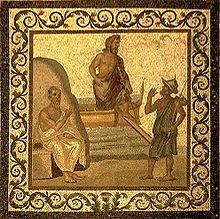Whatever its history and origin, we have a superb gold coin showing Alexander on the obverse and a tiptoeing elephant on the reverse.
This may well be the best-kept secret about Alexander for the past ten years or so, a golden coin showing us Alexander with the elephant headdress, the horns of Ammon, the Gorgon around his neck, and the coiling snakes worn as an aegis, but with an unfamiliar face. With his wide-open eyes, crooked nose, and wild curls, he reminds us of the picture on the mosaic from Pompeii. For once, his image has not been idealized! This is believed to be the only portrait created during Alexander the Great's lifetime to survive into modernity. The coin's reverse shows a cute dancing elephant; this image, together with the elephant skin on Alexander’s head, connects the coin immediately to his battle against Porus on the Hydaspes in India in 326 BC. This is Alexander as he saw himself - invulnerable, verging on godhood, immortalized in the moment of his triumph.
We must remember the small ivory head found at the Tomb in Vergina and said Pompeian mosaic to find another picture of Alexander-true-to-life, which has been kept away from us?
Well, not entirely, although I personally have had no knowledge of its existence until now. A dear friend sent me an article from the Sunday Times, “Getting hold of the Alexander Medallion,” dated 25 September 2011. How could I have missed such important news? After further investigation, I found a similar article in the Greek Reporter, which in turn is dated 4 April 2014. What has happened here?
Both articles are detailed and refer to the famous hoard found at Mir Zakah in north-eastern Afghanistan, a village along the ancient road from Ghazni in Afghanistan to Gandhara in Pakistan. The hoard had been hidden in a well for over two thousand years and contained an estimated 550,000 coins and hundreds of other objects in silver and gold. The oldest pieces date back to the 5th century BC; the most recently belong to the 2nd century AD.
Osmund Bopearachchi was the first to recognize the medallion in 1993. It has since then been evaluated and discussed by many scholars and ended in a fight about whether it is authentic or fake. For this study and scrutiny, Bopearachchi luckily called in the help of Frank Holt, famous for his research on the Elephant Medallions (see: Alexander the Great and the Mystery of the Elephant Medallions). With Frank Holt in the picture, my own skepticism soon ebbed away.
Digging in further, I discovered that Osmund Bopearachchi and Frank Holt have co-written a book on this very medallion, “The Alexander Medallion, Exploring the Origins of a Unique Artefact.” The bottom line is that there should be no doubt about the authenticity of this coin. It is not because it is unique that one should automatically label it fake. Picking it by chance from among the countless bags of coins is the proverbial needle in a haystack of nearly 4 tons of gold. The hoard had been stuffed in sacks of about 50 kg each, which found their way to the obscure bazaars of Peshawar, where they were sold by the bag. Bopearachchi came to see what he called “a rain of coins” and tried desperately to sort the coins out by their origins, Greek city-states, Seleucid, Indo-Greek, Indo-Scythian, Indo-Parthian, Kushan, but the task was colossal! Were there any more Alexander Medallions? Who knows.
The entire context of this hoard and the Alexander Medallion, in particular, is primarily complicated because it was found in a war zone. Where initially, Afghan authorities could stamp some influence on what was excavated, things soon ran out of hand after the invasion of the Allied forces and the growing power of the Taliban. Located on a vague border between Afghanistan and the northwest of Pakistan, where warlords impose and apply laws of their own, people need to learn what is going on. Any treasure quickly moves from hand to hand and is ushered out of the country to potential buyers in America and Europe. The case of the Mir Zakah hoard was no exception, and the coins were sold by the bag without any qualified investigation.
The bottom line is that both Osmund Bopearachchi and Frank Holt accepted the medallion as authentic and minted during Alexander’s lifetime after he invaded India in 326 BC. As Holt puts it: Since we cannot prove this is a forgery, we can only assume it is genuine. Let’s not forget that for a forger to “create” this otherwise unknown coin, had to be exceptionally well trained in ancient coin making, knowledgeable in the history of Alexander to include so many of the recognizable elements of this medallion (headdress, Gorgon, Ammon horns), as well as in minting gold, which I honestly think is impossible.
Meanwhile, some three tons of these valuable coins are stashed in the vaults of a bank in Basle, Switzerland awaiting a multimillionaire buyer despite repeated calls (including UNESCO) to at least allow numismatic scholars to study the content.
[Bottom picture is from The Greek Reporter]
Meanwhile, some three tons of these valuable coins are stashed in the vaults of a bank in Basle, Switzerland awaiting a multimillionaire buyer despite repeated calls (including UNESCO) to at least allow numismatic scholars to study the content.
[Bottom picture is from The Greek Reporter]

















